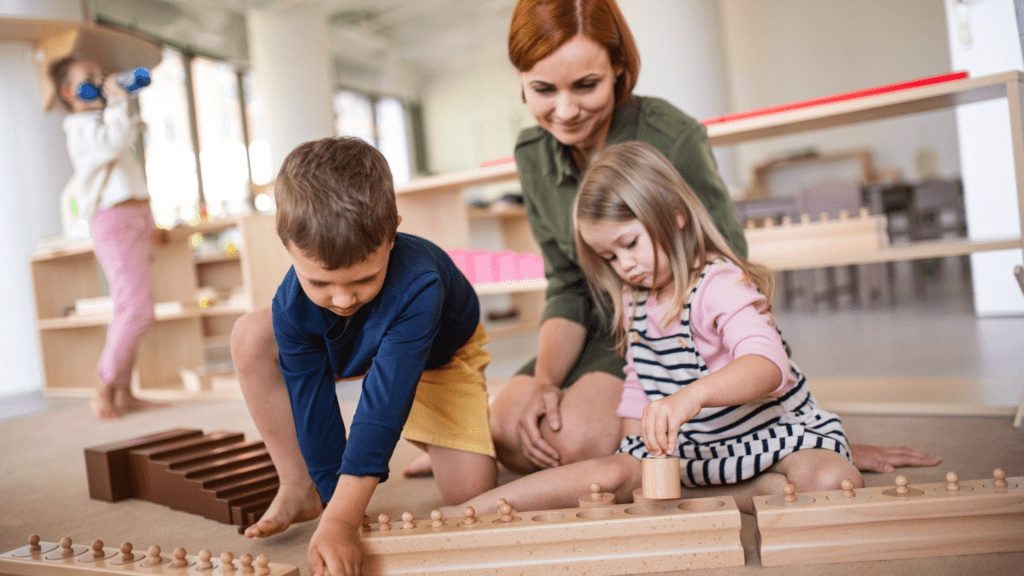Montessori’s original work cycle stipulates that a child should always have a task at hand, ready to be completed. This is a fundamental aspect of Montessori education, which has enjoyed widespread success in the past.
In this section, we will delve into how Montessori’s original work cycle can benefit children and facilitate their learning. The Montessori work cycle comprises four components: free exploration, guided exploration, hands-on activities, and independent tasks.
Before we explore the Montessori work cycle further, let’s gain a comprehensive understanding of the Montessori method of education.
Introduction to Montessori Method of Education
Maria Montessori first developed this method of education in the first decade of the 20th century. The philosophy behind this teaching approach revolves around developing independence and fostering a love of learning among children.
A Montessori environment is a place where children are encouraged to learn through self-directed play, natural curiosity, and collaborative work with others. They learn how to respect their own thoughts and those of others, as well as how to work with one another.
This kind of approach develops the maximum potential of the child. Montessori classrooms are beautifully crafted with the concept called prepared environment to meet the age-specific requirements and help them to learn about themselves and their world. This fosters a solid foundation for the further progress of the child.
Also Check: Montessori Circle Time: Purpose and Activities
What is a Montessori Work Cycle?
As I mentioned in the above section, the Montessori way to education is distinguished for its emphasis on independence, freedom of movement, respect for a child’s nature, and educational use of self-correcting materials that are presented at the appropriate level of difficulty.
As a result, on a daily basis, the child follows instructions to do a specific job, but during a period of time when the child is free and can work independently, this is known as the Montessori Work Cycle. The child is encouraged to work at their own pace and interest without any assistance or guidance during the work cycle hours. They are free to choose any materials in the classroom and are encouraged to work according to their choices.
The Montessori work cycle is quite a lengthy period, say around 3 hours or so, where the child does uninterrupted school work. Here, work refers to the choice of materials and things but in the school itself, and that is limited to a specific area.
It consists of selecting an activity, picking up related material, doing the tasks, and achieving internal satisfaction. The child is free to choose another activity once he is done with the first. At the end of each activity, a child is taught to keep things back properly so that another child may get involved in that activity.
This way a powerful success cycle is created that gives satisfaction, accomplishment, and contentment to the child. The child may move from one task to another, simpler to complex, and so on.
The tasks in the work cycle
4 major tasks are included in the Montessori Work Cycle. These benefit the children in various ways. The tasks include:
- Practical Life: Practicing table manners, washing dishes, dusting furniture, maintaining clean surroundings, understanding the day-to-day lifestyle
- Sensorial: Touching varied textures like rough, smooth, hard, soft textures, smelling different flowers, understanding fragrances, tasting fruits,
- Science: Observing leaves, exploring sound waves, getting versed with nature around us.
- Language Arts: Reading books about animals or insects, writing about an animal or insect’s life cycle.
Making Montessori Work Cycles Productive
The Montessori work cycle promotes creativity time for a child’s own projects because creativity time means free time for children to do projects they have been interested in or been thinking about doing on their own initiative rather than being guided by an adult or teacher.
It is a teaching method that consists of 3 phases
- The preparatory phase/ Preparation for Work: Preparation time is a necessary part of work, allowing the child to prepare his space and materials for work.
- The productive phase/ Work Properly Executed: Executing a good quality of work is important to every task in life. It is the phase in which the child can freely explore their surrounding environment and complete the task given to them by their teachers.
- The concluding phase/ Routine Cleaning Up at the End of Work Cycle: To complete the cycle, one must end with a thorough cleaning up of their space at the end of the working day. It is to make sure that the resources are ready to use again for another cycle or project.
Must Read: How Does a Montessori Curriculum Look like?
Examples of Montessori Work Cycle activities may include
● Vocabulary building cards – building vocabulary through pictures and associated words
● Fine motor activities- Using finger pincer grip tools, chalk, and board, blocks
● Language development- Sound baskets with matching objects or letter sounds is a good idea for language development
● For older children opting for some math are related to quantities and numbers could be a good option
● Writing skills can also be enhanced by offering different writing tools including colors
● Various shapes like cones, cylinders, cubes, and cuboids can be placed on the shelf to help the child understand the world of shapes and structures.
● Jigsaw puzzles or shape puzzles are a good choice for cognitive development.
Final Words
These are a few examples to set a colorful interactive classroom while the facilitator is set to try the Montessori Work Cycle.
Why only for schools and teachers, even parents can keep a fun day work cycle on some occasions at homes. Many of the corners or shelves can have the same concepts with different articles that can be found at home too.
Try a Montessori Work Cycle for a day and let us know how you made it better. Share your ideas with us and other mommies and of course facilitators and mentors too.



